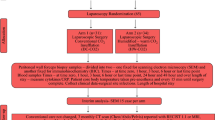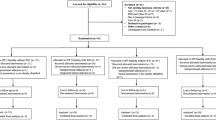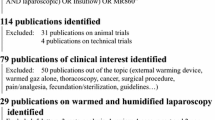Abstract
Background
Insufflation with CO2 can employ continuous flow, recirculated gas and/or additional warming and humidification. The ability to compare these modes of delivery depends upon the assays employed and opportunities to minimize subject variation. The use of pigs to train colorectal surgeons provided an opportunity to compare three modes of CO2 delivery under controlled circumstances.
Methods
Sixteen pigs were subjected to rectal resection, insufflated with dry-cold CO2 (DC-CO2) (n = 5), recirculated CO2 by an AirSeal device (n = 5) and humidification and warming (HW-CO2) by a HumiGard device (n = 6). Peritoneal biopsies were harvested from the same region of the peritoneum for fixation for immunohistochemistry for hypoxia-inducible factor 1 alpha (HIF-1α) and scanning electron microscopy (SEM) to evaluate hypoxia induction or tissue/cellular damage, respectively.
Results
DC-CO2 insufflation by both modes leads to significant damage to mesothelial cells as measured by cellular bulging and retraction as well as microvillus shortening compared with HW-CO2 at 1 to 1.5 h. DC-CO2 also leads to a rapid and significant induction of HIF-1α compared with HW-CO2.
Conclusions
DC-CO2 insufflation induces substantive cellular damage and hypoxia responses within the first hour of application. The use of HW-CO2 insufflation ameliorates these processes for the first one to one and half hours in a large mammal used to replicate surgery in humans.





Similar content being viewed by others
References
Machairas N, Charalampoudis P, Molmenti EP, Kykalos S, Tsaparas P, Stamopoulos P, Sotiropoulos GC (2017) The value of staging laparoscopy in gastric cancer. Ann Gastroenterol 30:287–294
Minig L, Achilarre MT, Garbi A, Zanagnolo V (2017) Minimally invasive surgery to treat gynecological cancer: conventional laparoscopy and/or robot-assisted surgery. Int J Gynecol Cancer 27:562–574
Ta R, O’Connor DB, Sulistijo A, Chung B, Conlon KC (2018) The role of staging laparoscopy in resectable and borderline resectable pancreatic cancer: a systematic review and meta-analysis. Dig Surg 36(3):251–260
Tan GHC, Shamji T, Mehta A, Chandrakumaran K, Dayal S, Mohamed F, Carr NJ, Rowaiye B, Cecil T, Moran BJ (2018) Diagnostic and therapeutic laparoscopy in assessment and management of patients with appendiceal neoplasms. Int J Hyperth 34:336–340
Zheng J, Feng X, Yang Z, Hu W, Luo Y, Li Y (2017) The comprehensive therapeutic effects of rectal surgery are better in laparoscopy: a systematic review and meta-analysis. Oncotarget 8:12717–12729
Melotti G, Tamborrino E, Lazzaretti MG, Bonilauri S, Mecheri F, Piccoli M (1999) Laparoscopic surgery for colorectal cancer. Semin Surg Oncol 16:332–336
Binda MM (2015) Humidification during laparoscopic surgery: overview of the clinical benefits of using humidified gas during laparoscopic surgery. Arch Gynecol Obstetr 292:955–971
Dean M, Ramsay R, Heriot A, Mackay J, Hiscock R, Lynch AC (2017) Warmed, humidified CO2 insufflation benefits intraoperative core temperature during laparoscopic surgery: a meta-analysis. Asian J Endosc Surg 10:128–136
La Falce S, Novara G, Gandaglia G, Umari P, De Naeyer G, D’Hondt F, Beresian J, Carette R, Penicka M, Mo Y, Vandenbroucke G, Mottrie A (2017) Low pressure robot-assisted radical prostatectomy with the airseal system at OLV hospital: results from a prospective study. Clin Genitourin Cancer 15:e1029–e1037
Binda MM, Molinas CR, Hansen P, Koninckx PR (2006) Effect of desiccation and temperature during laparoscopy on adhesion formation in mice. Fertil Steril 86:166–175
Bloechle C, Kluth D, Holstein AF, Emmermann A, Strate T, Zornig C, Izbicki JR (1999) A pneumoperitoneum perpetuates severe damage to the ultrastructural integrity of parietal peritoneum in gastric perforation-induced peritonitis in rats. Surg Endosc 13:683–688
Davey AK, Hayward J, Marshall JK, Woods AE (2013) The effects of insufflation conditions on rat mesothelium. Int J Inflamm 2013:816283
Erikoglu M, Yol S, Avunduk MC, Erdemli E, Can A (2005) Electron-microscopic alterations of the peritoneum after both cold and heated carbon dioxide pneumoperitoneum. J Surg Res 125:73–77
Hazebroek EJ, Schreve MA, Visser P, De Bruin RW, Marquet RL, Bonjer HJ (2002) Impact of temperature and humidity of carbon dioxide pneumoperitoneum on body temperature and peritoneal morphology. J Laparoendosc Adv Surg Tech A 12:355–364
Molinas CR, Tjwa M, Vanacker B, Binda MM, Elkelani O, Koninckx PR (2004) Role of CO(2) pneumoperitoneum-induced acidosis in CO(2) pneumoperitoneum-enhanced adhesion formation in mice. Fertil Steril 81:708–711
Andrews PM, Porter KR (1973) The ultrastructural morphology and possible functional significance of mesothelial microvilli. Anat Rec 177:409–426
Slater NJ, Raftery AT, Cope GH (1989) The ultrastructure of human abdominal mesothelium. J Anat 167:47–56
Neuhaus SJ, Watson DI (2004) Pneumoperitoneum and peritoneal surface changes: a review. Surg Endosc 18:1316–1322
Tarhan OR, Barut I, Ozogul C, Bozkurt S, Baykara B, Bulbul M (2013) Structural deteriorations of the human peritoneum during laparoscopic cholecystectomy. A transmission electron microscopic study. Surg Endosc 27:2744–2750
Carpinteri S, Sampurno S, Bernardi MP, Germann M, Malaterre J, Heriot A, Chambers BA, Mutsaers SE, Lynch AC, Ramsay RG (2015) Peritoneal tumorigenesis and inflammation are ameliorated by humidified-warm carbon dioxide insufflation in the mouse. Ann Surg Oncol 22(Suppl 3):S1540–S1547
Peng Y, Zheng M, Ye Q, Chen X, Yu B, Liu B (2009) Heated and humidified CO2 prevents hypothermia, peritoneal injury, and intra-abdominal adhesions during prolonged laparoscopic insufflations. J Surg Res 151:40–47
Sammour T, Kahokehr A, Hayes J, Hulme-Moir M, Hill AG (2010) Warming and humidification of insufflation carbon dioxide in laparoscopic colonic surgery: a double-blinded randomized controlled trial. Ann Surg 251:1024–1033
Azuar AS, Matsuzaki S, Darcha C, Dechelotte PJ, Pouly JL, Mage G, Canis M (2009) Impact of surgical peritoneal environment on postoperative tumor growth and dissemination in a preimplanted tumor model. Surg Endosc 23:1733–1739
Mathew G, Watson DI, Rofe AM, Ellis T, Jamieson GG (1997) Adverse impact of pneumoperitoneum on intraperitoneal implantation and growth of tumour cell suspension in an experimental model. Aust N Z J Surg 67:289–292
Wison RB (2017) Changes in the coelomic microclimate during carbon dioxide laparoscopy: morphological and functional implications. Pleur Peritoneum 2:17–31
Brokelman WJ, Lensvelt M, Borel Rinkes IH, Klinkenbijl JH, Reijnen MM (2011) Peritoneal changes due to laparoscopic surgery. Surg Endosc 25:1–9
Marshall JK, Lindner P, Tait N, Maddocks T, Riepsamen A, van der Linden J (2015) Intra-operative tissue oxygen tension is increased by local insufflation of humidified-warm CO2 during open abdominal surgery in a rat model. PLoS ONE 10:e0122838
Matsuzaki S, Vernis L, Bonnin M, Houlle C, Fournet-Fayard A, Rosano G, Lafaye AL, Chartier C, Barriere A, Storme B, Bazin JE, Canis M, Botchorishvili R (2017) Effects of low intraperitoneal pressure and a warmed, humidified carbon dioxide gas in laparoscopic surgery: a randomized clinical trial. Sci Rep 7:11287
Matsuzaki S, Jardon K, Maleysson E, D’Arpiany F, Canis M, Botchorishvili R (2012) Impact of intraperitoneal pressure of a CO2 pneumoperitoneum on the surgical peritoneal environment. Hum Reprod 27:1613–1623
Sammour T, Hill AG (2015) Five year follow-up of a randomized controlled trial on warming and humidification of insufflation gas in laparoscopic colonic surgery-impact on small bowel obstruction and oncologic outcomes. Int Surg 100:608–616
Sammour T, Kahokehr A, Hill AG (2008) Meta-analysis of the effect of warm humidified insufflation on pain after laparoscopy. Br J Surg 95:950–956
Carpinteri S, Sampurno S, Malaterre J, Millen R, Dean M, Kong J, Chittleborough T, Heriot A, Lynch AC, Ramsay RG (2018) Experimental study of delivery of humidified-warm carbon dioxide during open abdominal surgery. Br J Surg 105:597–605
Jenks M, Taylor M, Shore J (2017) Cost-utility analysis of the insufflation of warmed humidified carbon dioxide during open and laparoscopic colorectal surgery. Expert Rev Pharmacoecon Outcomes Res 17:99–107
Mason SE, Kinross JM, Hendricks J, Arulampalam TH (2017) Postoperative hypothermia and surgical site infection following peritoneal insufflation with warm, humidified carbon dioxide during laparoscopic colorectal surgery: a cohort study with cost-effectiveness analysis. Surg Endosc 31:1923–1929
Mutsaers SE, Whitaker D, Papadimitriou JM (1996) Changes in the concentration of microvilli on the free surface of healing mesothelium are associated with alterations in surface membrane charge. J Pathol 180:333–339
Volz J, Koster S, Spacek Z, Paweletz N (1999) The influence of pneumoperitoneum used in laparoscopic surgery on an intraabdominal tumor growth. Cancer 86:770–774
Volz J, Koster S, Spacek Z, Paweletz N (1999) Characteristic alterations of the peritoneum after carbon dioxide pneumoperitoneum. Surg Endosc 13:611–614
Jaakkola P, Mole DR, Tian YM, Wilson MI, Gielbert J, Gaskell SJ, von Kriegsheim A, Hebestreit HF, Mukherji M, Schofield CJ, Maxwell PH, Pugh CW, Ratcliffe PJ (2001) Targeting of HIF-alpha to the von Hippel-Lindau ubiquitylation complex by O2-regulated prolyl hydroxylation. Science 292:468–472
Miyake S, Kitajima Y, Nakamura J, Kai K, Yanagihara K, Tanaka T, Hiraki M, Miyazaki K, Noshiro H (2013) HIF-1alpha is a crucial factor in the development of peritoneal dissemination via natural metastatic routes in scirrhous gastric cancer. Int J Oncol 43:1431–1440
LaGory EL, Giaccia AJ (2016) The ever-expanding role of HIF in tumour and stromal biology. Nat Cell Biol 18:356–365
Matsuzaki S, Jardon K, Maleysson E, D’Arpiany F, Canis M, Bazin JE, Mage G (2010) Carbon dioxide pneumoperitoneum, intraperitoneal pressure, and peritoneal tissue hypoxia: a mouse study with controlled respiratory support. Surg Endosc 24:2871–2880
Diana M, Noll E, Legner A, Kong SH, Liu YY, Schiraldi L, Marchegiani F, Bano J, Geny B, Charles AL, Dallemagne B, Lindner V, Mutter D, Diemunsch P, Marescaux J (2018) Impact of valve-less vs. standard insufflation on pneumoperitoneum volume, inflammation, and peritoneal physiology in a laparoscopic sigmoid resection experimental model. Surg Endosc 32:3215–3224
Hiller JG, Perry NJ, Poulogiannis G, Riedel B, Sloan EK (2018) Perioperative events influence cancer recurrence risk after surgery. Nat Rev Clin Oncol 15:205–218
Hiller JG, Sampurno S, Millen R, Kuruvilla N, Ho KM, Ramsay R, Riedel B (2017) Impact of celecoxib on inflammation during cancer surgery: a randomized clinical trial. Can J Anaesth 64:497–505
Acknowledgements
We thank the Centre for Advanced Histology and Microscopy for their expert advice regarding scanning electron microscopy and immunohistochemistry.
Author information
Authors and Affiliations
Corresponding author
Ethics declarations
Disclosures
This work was supported in part by the Epworth Hospital Research Foundation (Drs Lynch and Ramsay) and the National Health and Medical Research Council of Australia (Drs Heriot and Ramsay). Fisher and Paykel Healthcare made a loan of HumiGards for this study. Ms Sampurno, Drs Chittleborough, Carpinteri and Hiller and Heriot have no disclosures. Drs Lynch and Ramsay have received research grant funding from Fisher and Paykel Healthcare for separate small animal studies. Prof Ramsay also receives research support associated with unconnected clinical trials from Targovax, Oslo; Merck Serono, Germany and Beigene Sciences, Australia.
Additional information
Publisher's Note
Springer Nature remains neutral with regard to jurisdictional claims in published maps and institutional affiliations.
Rights and permissions
About this article
Cite this article
Sampurno, S., Chittleborough, T.J., Carpinteri, S. et al. Modes of carbon dioxide delivery during laparoscopy generate distinct differences in peritoneal damage and hypoxia in a porcine model. Surg Endosc 34, 4395–4402 (2020). https://doi.org/10.1007/s00464-019-07213-y
Received:
Accepted:
Published:
Issue Date:
DOI: https://doi.org/10.1007/s00464-019-07213-y




